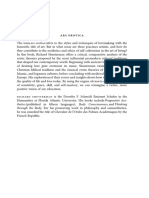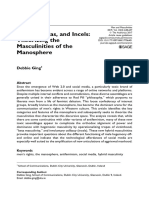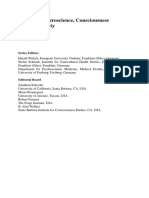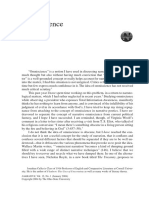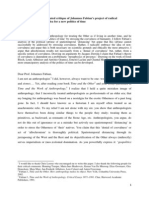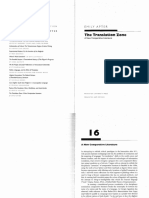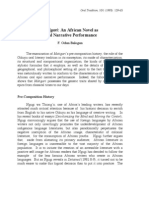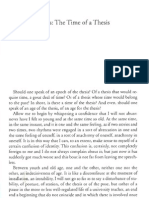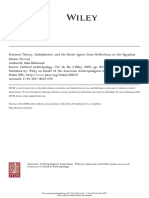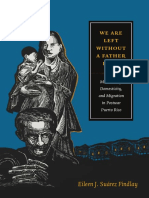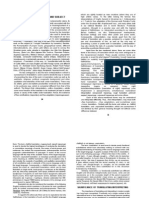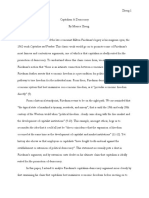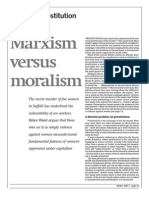The Main Enemy
The Main Enemy
Uploaded by
wilkersonmichaelCopyright:
Available Formats
The Main Enemy
The Main Enemy
Uploaded by
wilkersonmichaelOriginal Description:
Copyright
Available Formats
Share this document
Did you find this document useful?
Is this content inappropriate?
Copyright:
Available Formats
The Main Enemy
The Main Enemy
Uploaded by
wilkersonmichaelCopyright:
Available Formats
Christine Delphy
The Main Enemy
Since the birth of the Women's Liberation Movement in France, in the
United States, and wherever the question has been raised, the Marxist point of
view has been represented by a line elaborated outside of the movement
(common to the traditional Communist parties and to leftist groups) and
propagated in the movement by militant women from these groups.
This line generally appears unsatisfactory to women in the movement, as
much in terms of theory as in terms of strategy:
1. It does not take account of the oppression common to all
women.
2. It is centered not on the oppression of women, but on the
consequences of this oppression for the proletariat (cf. "Bread and
Roses"). i
This Marxist line is only possible at the price of a flagrant contradiction
between the principles which this line claims to uphold and the application which
it makes of these principles to the situation of women. Historical materialism is
based on the analysis of social antagonisms in terms of class, the classes
themselves being defined by their place in the production process. But, whereas
these principles have been supposedly used to analyze the situation of women as
women, in fact, the specific relationships of women to production have been
Originally published in a special double issue of the journal Partisans, entitled Libbration des
femmes: annbe zbro, 1970.
Feminist Issues / Summer 1980
24
ignored, resulting in a failure to carry out a class analysis. The results of such a
theoretical gap are not long in coming:
- - T h e oppression of women is seen as a secondary consequence of
(and derived from) the class struggle as it is currently defined - - that
is, as solely the oppression of the proletariat by capital.
- - T h e oppression of women in countries where capitalism as such has
been destroyed is attributed to purely ideological causes. This implies
a non-Marxist and idealist definition of ideology as a factor which
can subsist in the absence of a material oppression which it serves to
rationalize.
These postulates are in contradiction with the dynamic of the women's
movement: the development of women's awareness of two urgent needs:
- - A theoretical need - - to find the structural reasons why the
abolition of the relations of capitalist production as such is not
sufficient to free women.
- - A political need - - to constitute the women's movement as an
autonomous political force.
Scarcely born, the movement is thus confronted with this contradiction: at
the very moment when it is constituting itself into a revolutionary force, the only
analysis which integrates the women's struggle into a global revolutionary
perspective leaves out the first of these needs (the search for the causes of the
specific oppression of women), and offers no theoretical base for the second (it
permits but does not establish the necessity for the constitution of an
autonomous movement).
The consequences of this contradiction are immediately felt in the
movement by the appearance of a general malaise, of antagonistic factions, of a
difficulty in functioning. These are all due to the impossibility of defining a
coherent practice so long as a gap exists between the theory referred to and the
real oppression being attacked, and as long as the existence itself of the
movement as such is not solidly (that is, theoretically) based.
The existence of this Marxist line has the practical consequence of being a
brake on the movement, and this fact is obviously not accidental. Our objective
here is not to show the mechanisms by which this line was adopted by women
thdmselves, 2 nor to show how this constitutes further proof of the existence of
objective interests
and not limited to the capitalist class - - in the oppression of
women. Let it suffice to say that, by reason of its objective role in retarding the
liberation of women, this line can only be regarded as the act of groups interested
in the subjection of women; and by reason of its nonscientific character it can
only be regarded as a Marxist camouflage for theories which justify this
subjection - - that is, as an ideology. But to repeat, our objective is not to do a
-
Delphy
25
critique of this line point by point (a critique which will be made elsewhere), but
to try to provide to the movement what it crucially needs at this moment - - that
is, the bases for a materialist analysis of the oppression of women.
This concern certainly answers to an objective need of the movement, since
in 1969-1970 there appeared simultaneously various essays by feminists (separated by thousands of miles and having no contact with each other) trying to
conceptualize the oppression of women starting from its material basis: in the
United States the article by Margaret Benston on "The Political Economy of
Women's Liberation, "3 and that of Suzie Olah on "The Economic Function of
the Oppression of Women"; 4 in Cuba the article "Against Invisible W o r k " : and
in France an unpublished manifesto of the F. M.A. group (F6minisme, Marxisme,
Action). 6
Every society, in order to survive, has to create material goods (production)
and human beings (reproduction). These essays center their analysis of the
oppression of women on women's specific participation in production (and not
only in reproduction): on domestic work and child rearing analyzed as
productive work. In this respect they constitute the embryo of a radical feminist
analysis based on Marxist principles. Rejecting the pseudotheories which make
the family first and foremost the place for the ideological indoctrination of
"future producers" destined to indirectly sustain capitalist exploitation only, and
which ignore its economic function, these essays show that the family is the place
of economic exploitation: that of women. Having shown that domestic work and
child-rearing are: (1) the exclusive reponsibility of women, and (2) unpaid, these
essays conclude that women have, as a result of this, a specific relationship to
production, which is comparable to serfdom. However, it is not sufficient to stop
there. We must:
--Analyze the relationships between the nature of domestic goods
and services and the mode of production of these goods and services.
--Proceed to develop a class analysis of women.
--On the basis of this analysis, trace the main lines of the movement's
political perspectives, in terms of objectives, mobilization, and
political alliances.
Relations of Production Entered into by Women
All contemporary societies, including "socialist" societies, are based on the
unpaid labor of women for domestic services and child-rearing. These services
can only be furnished within the framework of a particular relationship to an
individual (the husband); they are excluded from the realm of exchange and
consequently have no value. They are unpaid. The allowances received by
women in return are independent of the work done and are not paid in exchange
26
Feminist Issues / Summer 1980
for that work, i.e., as a wage to which their work entitles them, but as a gift. The
husband's only obligation, which is obviously in his own interest, is to provide for
his wife's basic needs, in other words, to maintain her labor power.
In the American and Cuban texts cited above, there remains an ambiguity,
or rather a remnant of the dominant ideology. While it is recognized that
domestic work is productive, it is nevertheless suggested - - or explicitly said - that its nonvalue, its nonremuneration, and its exclusion from the domain of
economic exchange are the consequence of the very nature of domestic services.
This idea is based on and is expressed by two postulates about women:
1. That they are"structurally not responsible for the production
of goods w and are "excluded from the realm of surplus value."
2. That they are restricted to activities which produce "only use
values" and not "exchange values," creating no "surplus value. ,,8
We maintain, on the contrary, that rather than its being the nature of the
work done by women which explains their relations of production, it is these
relations of production which explain the fact that their work is excluded from
the realm of value. It is women as economic agents who are excluded from the
(exchange) market, and not their production.
I. The relations of production described above (nonremuneration) as
applying to domestic work are not limited to products consumed within the
family (child-rearing, domestic services) but also apply to products destined
for the market when they are produced within the family.
Women's participation in the creation of goods and vital necessities is
attested to by the whole ethnographic literature, and this constitutes an obstacle
for ideologists who try to explain the inferior status of women by their secondary
role - - at least"in the beginning"-- in the "survival of the species."This is not the
place to discuss the phenomenon of how the "naturalist" ideology which
underlays the system has been made into a myth of its origins, which is projected
at will into all moments of history - - a myth of which Engels himself was a victim.
Suffice it to say that ethnographic documentation as a whole shows that the
economic importance of the goods produced by women or by men is not related
to the social preeminence of one or the other sex. On the contrary, all data
(ethnographic, as well as sociological) reveal an inverse relationship: the
dominant classes have the productive work done by the classes they have in their
power.
In France today women's work may be unpaid not only when it is applied to
products for domestic use, but also when it is applied to goods for the market.
This is true in all the sectors where the unit of production is the family (in contrast
to the workshop or the factory), i.e., in most agriculture, in small businesses, and
in craft workshops. Women's work is by no means marginal: in 1968 farmers'
Delphy
27
wives devoted on an average four hours a day to agricultural work. 9 The "rural
crisis" is largely due to the fact that girls no longer want to marry farmers. In the
general view, "a farm cannot be run without a woman." Michelet said that when a
farmer could not pay a servant, he took a wife. This is still true. "Michel needs
someone to help him, and he can't find a servant. If only he would get marr i e d . . . " 1 In France the jobs assigned to women on farms vary from region to
region. Animal care (poultry, pigs, etc.) is a constant. Besides that, they are
general help on the farm; they are the assistants, the workers on whom fall the
subordinate, dirty, difficult, nonmechanized tasks (particularly the milking of
cows when it is done by hand, a job which ties them to such an uncongenial
schedule that some women now demand to be exempted from it in their marriage
contract; men take over this job when it becomes mechanized). Often the only
source of cash for the purchase of items not produced on the farm is the sale of
goods specifically produced by the wife: milk, eggs, poultry. However, whatever
her designated tasks on the farm may be, the woman's work is absolutely
necessary. A man alone cannot run a farm without assuming a double work load,
and in fact he cannot run it at all, even by limiting himself only to the farm work
(a man alone without children does not need a great many domestic services).
The wife's unpaid labor thus counts in the general economy of the farm, as
well as the unpaid labor of younger brothers and sisters, who are literally
disinherited, and that of children. Although today in the majority of cases
younger siblings and children threaten to leave, or actually do leave, unless they
are paid a wage, it is important to remember that their exploitation was the rule
in all sectors of the economy until industrialization (the end of the eighteenth
century), and until the Second World War in agriculture.
Historically and etymologically the family is a unit of production. Familia
in Latin designates the totality of the land, the slaves, the women, and the
children who are under the control of (synonym for the property of) the father of
the family. The father of the family dominates this unit: the labor of the
individuals under his authority belongs to him. In other words, the family is that
group of individuals who owe their labor to one "boss."
Since the family is based on the exploitation by one individual of those who
are related to him by blood or marriage, this exploitation exists wherever the
mode of production is familial. In Morocco, for example: "In the rural area
women look after fruit-picking and animal care. These women receive no
payment for their work; they are entitled to their support by the head of the
family."l i
In France today seven million women are designated as "employed," that
is, as participating in production. Of these seven million, one million are "family
helpers," which means unpaid; almost eight out of ten of these unpaid women are
employed in agriculture. The category of "family helper" is the ratification of
exploitation within the family, since it institutionalizes the fact that some
28
Feminist Issues / Summer 1980
producers are not paid, that is, that the profit from their production belongs to
their relative, husband or father.
Many wives of farmers, merchants, and craftsmen nevertheless continue to
declare themselves to be "just a housewife." Also, the number of women who
participate in the production of goods in the framework of family businesses is
certainly larger than the number of women counted in the census as "family
helpers." Assuming that the number is underestimated by 40%, one comes up
with an estimate of 1,400,000 women out of 14 million adult women (between 17
and 64 years of age) who are subject to these relations of production, that is, one
woman in ten.
The unpaid character of women's work continues to be taken for granted,
even when the unpaid character of children's work is being called into question.
More and more frequently, when a farming household is made up of different
generations, the son demands to be paid for his work, and notjust"recompensed"
by the mere maintenance of his labor power; but the suggestion that the wife
could demand the same thing, that the couple should receive two wages for two
jobs, is met with total incomprehension. Unpaid work by men is thus strongly
attacked (only one out of 43 "employed" men is a family helper, compared to one
out of 7 "employed" women), while unpaid work by women is institutionalized
not only in practice but also in government bookkeeping (using the category of
family helper) and in the demands of opposition political parties: the
M.O.D.E.F. 12 demands that each family farm be assured of having an income
equivalent to one wage. The implication is that the wife's work, incorporated fnto
household production, does not merit a wage; or, rather, that since the wife's
production is exchanged by the husband as his own, the wife's work belongs to
her husband.
11. There is no difference between the domestic services provided by wives
and other goods and services, called productive, which are produced and
consumed in the family.
In the traditional farm economy a large part of the goods consumed by the
family are produced by it: it absorbs directly a part of its own production.
However, this production is also saleable; that is, there is no distinction between
use value and exchange value. The same product which is consumed by the
family and which has a use value for it also naturally has an exchange value, since
it can be taken to market. On the other hand, if it were not self-produced, it would
have to be replaced by its equivalent bought on the market.
For this reason farm produce which is self-consumed is considered as
income by those concerned and as production in the national accounting. The
only question which comes up in national accounting is whether a pig eaten by
Delphy
29
the family should be evaluated at its production cost, the price for which it could
have been sold (that is, by the farm's would-be gain), or at its replacement price,
the price the household would have had to pay if it had not produced it (that is, by
the farm's would-be expense).
When producer and consumer are one, as in the farm family, it is obvious
that there is a continuum between production and consumption: wheat is sown in
order to consume it; it is milled because it is not consumable as grain; it is cooked
because it is not consumable as flour; and none of these operations is useful
without the others, because the objective is the final consumption. It is thus
absurd to introduce a break in this process. This is, nevertheless, what happens
when only a certain part of this process is entered into the books as productive-up to and including the production of flour - - and when the rest of the process,
the baking of the bread, for example, is considered as nonproductive. Either all
the work involved in producing the self-consumed product is productive, or none
of it is. The latter hypothesis is absurd, because the pig which is eaten could have
been sold on the market, and would have had to be replaced by its equivalent in
food purchased. This is what happens with farmers who produce only one crop
or animal, and even more so with workers who produce nothing that can be
consumed. What masks the fact that the objective of all production is ultimately
consumption is the fact that in these cases products must be exchanged twice
before they can be consumed (sale of the product Qf one's work and purchase of
the product to be consumed). What introduces a break into the productionconsumption continuum is not the fact that certain activities necessary to the
final goal (consumption) are not productive, but the fact that when production is
specialized, consumption (the final objective of all production) is mediated by
exchange.
The example of self-consumption on the farm illustrates clearly the fact
that there is no difference in nature between the activities called "productive"
(like fattening a pig) and household activities called "nonproductive" (like
cooking the said pig).
To summarize, in agriculture women and men together create use values
which are:
1. Essentially exchange values: women and men produce milk,
eggs, and agricultural produce for their own consumption and for
exchange; the desired level of consumption and the desired quantity
of cash determine what goes to the market and what is self-consumed.
2. Entered into the accounts as production (in the gross national
product).
So-called productive use values are no different from so-called nonproductive use values created by "purely domestic" labor; they are part of the same
process of creation and of transformation of raw products (they are directed at
30
Feminist Issues/Summer 1980
the same raw products for the production of consumable food), and they have the
same end: self-consumption) 3
IlL Just as there is continuity and no break between the activities aimed at
self-consumption and called productive and the activities aimed at selfconsumption and called nonproductive (household activities), so there is a
continuity between the services provided without pay by women and
commercialized services.
Today many of the operations leading to the transformation of raw
materials into consumable products have been industrialized; operations which
formerly were part of household activities are now carried out outside of the
house - - activities such as bread-making, dressmaking, and preparation of
preserved foods. Today bakeries, clothing manufacturers, and canning and
freezing companies sell labor which was previously provided without pay by
women. This manufacturing is considered as production and is officially counted
in the gross national product: the labor involved in it is considered as productive
and the individuals who carry out this work as producers - - which was not the
case as long as the goods were produced by the unpaid labor of women.
Most of these operations are no longer done by wives; they are not different
in nature from domestic operations such as housework, cooking, child care,
which continue to be carried out without pay by women in most cases. The fact
that when women provide these services outside of the family, they are paid for
them proves again that the lack of pay does not depend on the character of the
work.
When these services cannot be provided by women in families, they must be
procured by purchase. All these domestic services exist in fact on the market:
delicatessens and restaurants offer prepared dishes, day-care centers and
babysitters offer child care, cleaning agencies and servants carry out housework, etc.
Expenditures for food constitute the principal item in household budgets
(from 50% to 80%). The household has a choice between buying ready-to-eat
food (thus paying for the value added to the raw materials by the paid labor of the
restaurateur, caterer, etc.) and buying it in raw form and applying to it the
amount of labor necessary to make it consumable. The greatest part of the food
budget is spent on the purchase of raw materials: "It can be said that the
household itself produces final products for consumption. In order to do this the
household essentially uses labor (domestic), machines (durable goods), and raw
materials (intermediary products bought directly from the manufacturing firms),
which are transformed by the household itself with the aid of a certain amount of
labor and capital. Looked at in this way, the household is different from the firm
only in that the household adds to production (which is the sole function of the
Delphy
31
firm) the activity of consumption (which is the goal of the production carried out
by the household itself with the aid of goods produced by the firm). TM
The final goal of production for the producer is consumption, whether it be
of his own products in a subsistence economy, or of other Products in a
specialized economy (as the final goal of production for the buyer is the
consumption of these products). The wages derived from the exchange of
specialized production or from labor power on the market is not sufficient to
accomplish this goal. This goal is reached in two stages:
--By the purchase of raw materials for consumption with a wage
earned by paid work.
--The transformation of these primary materials into directly
consumable products, by virtue of household labor.
"We have then, on the one hand, work inside the house which provides a
certain quantity of directly consumable goods; and, on the other hand, outside
work which brings in a certain monetary income. But what is the utilization of
this monetary income? We suggest that it does not directly consist of the
usefulness of the goods that this income purchases, as the traditional theory
alleges; but, according to our hypotheses, that it consists of the contribution of
this income to the production of consumable final goods; that is, that it consists
of the contribution of capital goods acquired with this income (raw material and
durable goods) to the production of consumable final goods. ''15
What this bourgeois economist does not mention is that if most "households" prefer to buy food in a raw form it is because household labor is unpaid
and because this labor is entirely provided by wives. One can oppose these facts
to the ideology which says that the husband's wage alone pays for the total
consumption of the household, while the housewife "does not earn her living."
In France in 1955 out of 105 billion work hours, 43 billion were devoted to
paid work, and 45 billion to unpaid domestic work) 6 The Swedish National
Accounting Office incorporates this unpaid labor into the gross national product
and evaluates it at one-fifth of the total. 17 In 1958 in France, married women
provided on the average 60 hours a week of unpaid domestic labor: 35 hours for
women with no children, 52 hours for women with one child, 64 hours for women
with two children, 70 hours for women with three children) g
To conclude, the exclusion of women's work from the field of exchange
does not result from the nature of their production since their unpaid work is
applied to:
1. The production of goods and services which reach and are
exchanged on the market (in agriculture, crafts, and business).
2. The production of goods and services which are remunerated
when performed outside of the family, and not remunerated when
performed in the family. And this applies to all production carried
out in the family, whatever its nature.
32
Feminist Issues [ Summer 1980
IV. Nowadays the appropriation of women's labor power tends to be limited
to the exploitation (the unpaid provision by them) of domestic work and
child rearing.
With the advent of industrialization the family was dispossessed of its
function as a unit of production, except in certain sectors. Industrialization
means principally that most production intended for the market can no longer be
done within the family.
As a result, none of this production can any longer incorporate the unpaid
work of wives and children. In other words, wives' work can no longer be
included in productions destined for exchange, since this production is carried
out outside the family. With the spread of this mode of production the number of
independent workers able to exchange the work of their wives is declining, while
the number of wage earners who cannot exchange this work is growing.
In the sectors where all the production intended for exchange is produced
by wage labor, the unpaid labor of the wife can only be applied to production
which is not intended for exchange. Or, more precisely, the mode of family
production - - the exploitation of wives' unpaid labor - - cannot be applied to
production intended for exchange. It must be said, however, that this is a
question of exchange by the husband. The wife, for example, is not paid for
agricultural labor if it is performed within the family: she cannot exchange her
family production on the market. She thus does not dispose of her own labor
power. It is her husband alone who can exchange the production of his wife on
the market. In the same way a woman does not dispose of her housework as long
as it is done in the family, and can only exchange it outside of the family. Thus
women's production always has an exchange value (can be exchanged by them)
except within the framework of the family. With the coming of industrialization
family production is limited to housework; or more precisely, we call housework
that to which the unpaid production of the wife has been reduced.
The entry of women into industry as wage earners is the immediate
consequence of the impossibility of totally exploiting their labor power. The
proportion of women wage earners in France remains the same today as it was in
1900. However, the appropriation of their labor power by their husbands is so
absolute that, even when women work outside of the family, their wage still
belongs to their husbands. Since 1907 a wife has the right - - in l a w - - to her own
wage, but in fact marriage custom annuls this concession (all the earnings go into
a common budget which the husband alone controls). Until 1965 the whole labor
power of the wife was appropriated: her husband could prevent her working
outside the home. These arrangements having been abrogated in 1965, it can be
said that since then women have legally recovered a part of their labor power.
Legally free to work outside of the home, a woman is not in fact free to do so. A
part of her labor power remains appropriated, since "she must fulfill her family
Delphy
33
responsibilities," that is, provide housework and child rearing without pay. Not
only does outside work not free her from housework, but also it must not
interfere with it either. The woman is thus free only to do a double work load in
exchange for a certain economic independence. The situation of the married
woman with a job clearly reveals the legal appropriation of her labor power. In
fact her providing of domestic work is no longer justified by the economic
exchange to which the servitude of the "housewife" is abusively assimilated. It
can no longer be maintained that domestic work is performed in exchange for
support and that this support is the equivalent of a wage, and that this work is
therefore paid. Women who go out to work support themselves and thus provide
this domestic work for nothing.
Moreover, when the wage of a woman who works "outside" is calculated by
the couple, the expenses of child care, extra taxes, etc., are deducted from her
wage alone, instead of being paid from the couple's income as a whole. This
shows that:
1. It is considered that these services should be free, in contrast
to services such as housing, transportation, etc., which are not
deducted from earnings.
2. It is considered that these services should be provided
exclusively by the wife, a part of her wage being considered by the
couple as nonexistent, serving to pay for what she should have done
free of charge.
Using these calculations, it is generally found by the couple that the wife
earns "almost nothing." In France, according to the 1968 census, 37.8% of
married women work outside the home. 19
V. On this basis, it is now possible to outline the premises of a class analysis.
The existence of two modes of production in our society is established:
(1) most goods are produced in the industrial mode; (2) domestic services, child
rearing, and a certain number of goods are produced in the family mode. The first
mode of production gives rise to capitalist exploitation. The second gives rise to
familial, or more precisely, patriarchal exploitation.
Out of about 15 million adult men, 307,000 men (family helpers) are subject
to the latter form of exploitation: they provide (mainly in agriculture) unpaid
skilled services within the family. All married women (that is, 80% of adult
women at all times) are subject to this exploitation: they provide at least unpaid
domestic services and child rearing within the family. The status of son or
younger brother, which is the basis of familial exploitation of men, is temporary;
the status of a woman lasts all her life. Moreover, male family helpers are not
exploited because they are men, while women are exploited because they are
women (wives). While other unpaid work on the farm, in the workshop or store
34
Feminist Issues / Summer 1980
can be furnished either by men or by women as members of a family, unpaid
housework is done exclusively by women as wives of the heads of households.
Women's labor is appropriated for all family production when the family is
the unit of production for the market (wives of farmers, craftsmen, and
shopkeepers - - about one million out of 15.5 million adult women). Women's
labor is appropriated solely for housework when the family no longer produces
directly for the market (wives of wage earners).
In the first case the woman's labor power is entirely appropriated; in the
second case it is totally appropriated if she does not work outside the home, or
partially appropriated if she does have an outside job (37.8% of married women
are "employed," but from this figure must be subtracted the family helpers - approximately 800,000 wives of farmers, craftsmen, and shopkeepers).
Thus the majority of married women do not have an independent income
and work in exchange for being supported. The difference between this mode of
production and the mode of capitalist wage-earning production does not lie in
the quantity of benefits furnished in exchange for work, in the difference between
the value of the support received and a hypothetical wage, but lies in the relation
of production itself.
The wage earner sells his labor power in exchange for a fixed wage which
depends on the services provided: these services are also fixed, defined in amount
(hours of work) and in type (qualification). The equivalents are determined
according to a fixed scale (that is, by a price determined by the total supply and
demand on the labor market in the capitalist system) - - a scale which is not
subject to the good will of the parties concerned. The individual employer and
employee do not influence the terms of the contract, and the individuals are
interchangeable. The labor which is furnished has a universal value, and it is this
value which the employer buys, and which the wage earner turns into money,
because he can take his labor power elsewhere. The fact that it is precise services
which are bought means that the wage earner can increase his earnings by
improving his services, either in amount or type.
The services which a married woman provides, on the contrary, are not
fixed: they depend on the will of the employer, the husband. Nor are these
services remunerated according to a fixed scale: the support furnished does not
depend on the work done by the wife, but on the wealth and good will of her
husband. For the same work (for example, the rearing of three children) the
support received by the wife of a worker and the wife of a business executive can
vary by as much as tenfold. Conversely, for the same support the wife furnishes
very different services depending on the needs of her husband. Thus the
housework of the wives of upper-class men is reduced in favor of social display
and conspicuous consumption. Since the benefits received bear no relationship
to the services provided, women do not have the option of improving their
services in order to increase their standard of living. The only solution for them is
Delphy
35
to provide the same services to a richer man: the logical consequence of the
nonvalue of their work is the competition for a good marriage. But even though
marriage with a man of the propertied class can raise the standard of living of a
woman, it does not make her a member of that class. She herself does not own the
means of production. Thus her standard of living does not depend on her class
relationship to the proletariat, but on her serf relations of production to her
husband. In the vast majority of cases the wives of bourgeois men whose
marriage ends must earn their own living as wage workers. They then become
concretely the proletarians that they to all intents and purposes were - - with the
added handicap of age a n d / o r the lack of professional training. Divorce reveals
women's virtual and real class position in the capitalist system.
The nonvalue of a woman's work is attested to by the fact that the services
rendered are independent of the support received. This is the consequence of the
impossibility of exchanging her labor, which itself is the consequence of the
impossibility of women's changing employers (it is sufficient to compare the
number of divorced women who remarry with the number of workers who
change jobs in the same year). The contract can be broken unilaterally even when
the wives continue to furnish adequate services (e.g., when given custody of the
children in a divorce, they get only child-support payments - - their work to rear
them is not paid - - when the payments are actually made).
T o summarize: while the wage earner depends on the market (on a
theoretically unlimited number of employers), the married woman depends on
one individual. While the wage earner sells his labor power, the married woman
gives hers: exclusive right and nonpayment are intimately linked.
VI. The furnishing o f unpaid labor within the framework o f a total and
personal relationship (marriage) constitutes precisely a relationship of
slavery. 2o
It can be said that since less than 10% of women over twenty-five years of
age are unmarried, the chances are very high that all women will be married at
some point in their lives, and that all women are doomed to enter into these
relations of production. As a group effectively (at any given time) subject to this
relation of production, they constitute a class; as a category of human beings
destined by birth to become members of this class, they constitute a caste. 2~
The appropriation and exploitation of their labor in marriage constitutes
the oppression common to all women. As women destined to become "the wife
of" someone, women destined for the same relations of production constitute a
single class. When they participate in capitalist production, they enter additionally into other relations of production. In France 5,900,000 women are integrated
into capitalist (i.e., nonfamily) production; of these 5,160,000 are wage earners,
and 675,000 are self-employed. In the whole of France 11,000 women are
36
Feminist Issues/Summer 1980
"industrialists." A tiny minority of women belong to the capitalist class, while the
majority of women who work outside the home belong to the proletariat. Within
this class, they constitute a super-exploited "caste." This fact is well known.
This super-exploitation is intimately connected to their specific exploitation as women.
In view of the preceding, it can be seen that it is about as accurate to say that
the wives of bourgeois men are themselves bourgeois as to say that the slave of a
plantation owner is himself a plantation owner. Nevertheless, this is heard all the
time. Likewise there is currently a confusion between the wives of workers and
women workers. That is to say, when speaking of women, sometimes their class
membership is based on a Marxist definition of class (on their relations of
production) and sometimes on an endorsement of the definition of women as the
property and extension of their husbands.
However, if only the capitalist mode of production is considered (as is
usually done), and if the same criteria are applied to women as to men, one
realizes that all women who do not work outside the home are outside the class
system (proletariat/capitalist). Otherwise, women can only be reintegrated into
the class system by determining their class membership according to nonMarxist criteria (by the class of their husbands). "Society is divided into classes,
and women are not outside these classes; consequently the lot of every woman is
linked to that of other women and men who belong to the same class and social
category. "22 By pretending that women belong to their husband's class in the
capitalist system, the fact that women precisely belong by definition to another
class in the other system than that of their husbands is masked. By claiming that
marriage can take the place of relations of production in the capitalist system as
the criterion for class membership in this system, one masks both the existence of
another system of production and the fact that the relations of production in this
latter system precisely place husbands and wives in antagonistic classes (the
former drawing a material benefit from the exploitation of the latter). And
finally, the "reintegration" of women into classes by defining them as property of
their husbands has as its objective precisely to hide the fact that they are the
property of their husbands.
In fact, if one only wanted to rally women to the anticapitalist struggle, it
would be enough to show that to the extent that they are integrated into this
mode of production (as wage workers) the vast majority of women (nine out of
ten women who work outside the home) have an objective interest in this struggle
insofar as they belong to the working class; whereas on the contrary, by
attributing to them the class of their husbands, the wives of the bourgeoisie (who
are not integrated into capitalist production) are made to look like enemies. One
sees thus that it is not so much a question of rallying all women to the
anticapitalist struggle as of denying the existence of a noncapitalist system of
production. In denying the existence of this system of production, the existence
Delphy
37
of relations of production specific to this system are denied, and those concerned
are prohibited from having the possibility of rebelling against these relations of
production. It is a question then, above all, of preserving the patriarchal mode of
production of domestic services - - that is, the unpaid furnishing of these services
by women. It is interesting in this regard to compare the current attitude of the
French Communist Party with Lenin's recommendations:
The real emancipation of women, real communism, will begin only
where and when an all-out struggle begins (led by the proletariat
wielding the state power) against this petty housekeeping, or rather
when its wholesale transformation into a large-scale socialist economy begins. 23 (italics in original)
The Communist Party solution is to
make household appliances available to all households to bring
about the mechanization of domestic services. 24
For the Communist Party it is the obligation of employers and the public
administration to
make it easier for the working woman to do her job as mother of a
family.25
Lenin:
Unfortunately, we may still say of many of our comrades, "Scratch
the Communist and a philistine a p p e a r s . " . . . Could there be any
more palpable proof than the common sight of a man calmly
watching a woman wear herself out with trivial, monotonous,
strength- and time-consuming work, such as her housework, . . Very
few husbands, not even the proletarians, think of how much they
could lighten the burdens and worries of their wives, or relieve them
entirely, if they lent a hand in this "women's work."
The Communist Party:
. . an equal division of difficulties and fatigue in the household is a
limited (sic) concept of equalityP (emphasis added)
Political Perspectives
In conclusion, patriarchal exploitation constitutes the common, specific,
and main oppression of women:
--Common: because it affects all married women (80% of all women
at all times).
--Specific: because the obligation to furnish unpaid domestic
services is only suffered by women
38
Feminist Issues / Summer 1980
--Main: because even when women work "outside," the class
membership that they derive from that work is conditioned by their
exploitation as women in the following ways: (a) access to the
ownership of the means of production was forbidden to them by
marriage rules (until 1968) and inheritance practices (the majority of
women employers are either "only children" or widows); (b) their
earnings are cancelled out by the deduction of the value of the services
which they are obliged to pay for to replace their own unpaid services;
(c) the material conditions for the exercise of their occupation are
dictated by their patriarchal oppression:
--The very possibility of working is conditional on their performing
first their "family duties," with the result that outside work is either
impossible or added to their domestic work.
--Family duties are established as a handicap and as a pretext by
capitalism to superexploit women in their outside work.
It has not been possible within the framework of this article to study the
relationship between the exploitation of women's productive labor and the
exploitation of their reproductive labor. The control of reproduction, which is
both the cause and the means of the other great material oppression of women - sexual exploitation - - , constitutes the second facet of the oppression of women.
Establishing why and how these two exploitations are conditioned and
reinforced by each other, and why and how they have the same framework and
the same institution-- the family - - must be one of the first theoretical objectives
of the movement.
This analysis constitutes a preliminary to the study of the relationship
between capitalism and patriarchy. It is important to know well what patriarchy
consists of in order to understand to what extent it is theoretically independent of
capitalism. Only this understanding will make it possible to account for the
historically observed independence of these two systems. Only by doing this is it
possible to establish the material basis for the articulation of the antipatriarchy
struggle and the anticapitalist struggle. As long as this articulation remains based
on unproven hierarchical postulates, a n d / o r on ideological voluntariness, we are
doomed to theoretical confusion and to political ineffectiveness in the short term,
and to historical failure in the long term.
These analyses must be followed by class analyses which integrate
individuals into both systems of exploitation (patriarchal and capitalist) based
on their objective interests. This is necessary in the short run in order to be able to
mobilize for the immediate struggle, and in the long run in order to envisage how
the dynamics of the antipatriarchy and anticapitalist struggles could be oriented
to combine them in revolutionary struggle. (Needless to say, this constitutes the
object of a continuing study whose basic principles would be constantly modified
by the evolution of the struggles.)
Delphy
39
For the present, one can say that women will not be liberated except by the
total destruction of the patriarchal system of production and reproduction. Since
this system is central to all known societies, this liberation implies the total
overthrow of the bases of all known societies. This overthrow cannot take place
without a revolution.
Mobilization for this struggle should be based on patriarchal oppression,
and thus includes all individuals oppressed by patriarchy and hence interested in
its destruction, that is, all women. The work of mobilization must emphasize the
solidarity of all people oppressed by the same system. To do this we must:
--Attack the problems of false consciousness, that is, class consciousness determined according to membership in capitalist classes rather
than in patriarchal classes, and the identification of women under this
pretext with the enemy patriarchal class.
- - S h o w how this false consciousness serves the interests of patriarchy
and detracts from our struggle.
For the present, the political and tactical alliances of the movement with
other groups, movements, or revolutionary parties must be based only on an
unambiguous commitment of the latter to the objectives of the movement - - on
the basis of their clearly and officially expressed intent to destroy patriarchy and
their positive participation in the revolutionary struggle which has this
destruction as its aim.
Notes
1. Kathy McAffee and Myrna Wood, "Bread and Roses," Leviathan 3 (June 1969). (Reprinted
in Leslie B. Tanner, Voicesfrom Women's Liberation [New York: Signet, 1970]).
2. These are mechanisms of alienation and false consciousness which serve to maintain
oppression: women are victims of oppression, not responsible for it.
3. Margaret Benston, "The Political Economy of Women's Liberation," Monthly Review 21,
no. 4 (September 1969). (Reprinted in Tanner, op. tit.). A French translation was included in the
original Partisans collection.
4. Suzie Olah, "The Economic Function of the Oppression of Women," in Shulamith
Firestone and Anne Koedt, Notes from the Second Year (New York, 1970).
5. Isabelle Larguia, "Contre le travail invisible," Partisans no. 54-55 (1970).
6. Cf. also an article in L'ldiot international, May 1970, which particularly emphasizes the
notion of menial work.
7. Benston, op. cit.
8. Larguia, op. cir.
9. Henri Bastide, "Les rurales," La Nef no. 38 (1969).
10. Personal communication from the mother of Michel, an unmarried farmer.
11. Article by Khadija Nouase in La Nef, no. 38 (1969).
12. Mouvement de Drfense des Exploitations Familiales, a French Communist Party
organization concerned with agriculture.
13. Ernest Mandel in his Marxist Economic Theory (New York: Monthly Review Press, 1968)
confirms that the terms use value and exchange value designate neither the nature nor the intrinsic
value nor the productivity of labor involved in diverse types of production, but simply the use to
which the production is put: immediate consumption or consumption mediated by exchange.
40
F e m i n i s t Issues / S u m m e r
1980
14. Alain Wolfelsperger, Les biens durables dans le patrimoine du consummateur (Paris:
Presses Universitaires de France, 1970), p. 20.
15. Ibid., p. 22.
16. D. Dayre in Etudes et Documents du Centre de Recherches Economiques et Sociales, May
1955.
17. The basis of this estimate is not known.
18. Alain Girard in Population, no. 4 (1958).
19. Claude Roux in Population et Societbs, no. 23 (1970).
20. I have been criticized for using the terms "serfdom" and "slavery" interchangeably.
Whereas this criticism exhibits a commendable degree of scholarly concern, it does not bear on my
work, as the attentive reader will have noticed for herself. The differences between slavery (which is
not, as the critics seem to assume, of just one variety; there is ancient, American and "new" [Slavic]
slavery, not to mention indenture and other species, each very different from the other, so that if one
wants to be really scholarly, it is impossible to talk of"slavery"at all) and serfdom (of which there are
also quite a few varieties) are, here, immaterial. What I am looking for in these analogies is their
common features, which are also what they have in common with marriage - - i.e., the extortion of
free work (as opposed to underpaid work or surplus value) within a personal (as opposed to
impersonal) contract. Cf. in my article "Protofeminism and Antifeminism" (which will appear in
Feminist Issues no. 4) my distinction between ~oppressions of allegiance," of personal dependence
(slavery, serfdom, marriage) and oppressions of impersonal dependence (vis-a-vis a class - - e.g.
capitalist exploitation).
21. In revealing fashion the wordfemme in French means both woman and wife [while there
are two words'in the case of males: marl meaning husband, and homme meaning man, Tr.]. In the
same way the word slave comes from Latin slavus, first meaning Slav, the ethnic population, and
then, as this whole population was doomed by conquest to servitude, it came to mean slave. In the
same way the whole female population is condemned to become the woman/wife of someone.
22. Parti Communist Francais, Les communistes et la condition de lafemme (Paris: Editions
Sociales, 1970), p. 129.
23. V.I. Lenin, Collected Works, Vol. 29 (Moscow: Progress Publishers, 1965), p. 429.
(Reprinted in The Emancipation of Women. From the Writings of V.I. Lenin [New York:
International Publishers, 1972], p. 64.)
24. Patti Communist Francais, op. cit.
25. Ibid.
26. Clara Zetkin, My Reminiscences of Lenin (New York: International Publishers, 1934).
(Reprinted in The Emancipation of Women. From the Writings of V.I. Lenin, p. 114.)
27. Patti Communiste Francais, op. cit. Such attitudes arc not restricted to the Communist
Party alone within the Left. Le Programme Commun, the platform of the recently formed coalition
of the Socialist Party and the Communist Party, recommends that women be allowed to leave their
outside jobs five minutes early in order to do the shopping for their families before the stores close. A
peculiar privilege indeed!
You might also like
- Susan Wolf: Sanity and The Metaphysics of ResponsibilityDocument8 pagesSusan Wolf: Sanity and The Metaphysics of ResponsibilityAllyssonNo ratings yet
- Ars Erotica by Richard ShustermanDocument436 pagesArs Erotica by Richard Shustermanmarian goleaNo ratings yet
- Latin Deverbal Presents in Aa - de VaanDocument21 pagesLatin Deverbal Presents in Aa - de VaanAdam PaulukaitisNo ratings yet
- The Way The World Is Author by Nelson GoodmanDocument10 pagesThe Way The World Is Author by Nelson GoodmanZhennya SlootskinNo ratings yet
- Symantec MSS Portal Users GuideDocument190 pagesSymantec MSS Portal Users GuideBojo Olalia100% (1)
- Feminism and The Question of Class - ALEXANDRA KOLLONTAI PDFDocument2 pagesFeminism and The Question of Class - ALEXANDRA KOLLONTAI PDFSvac MartinicNo ratings yet
- Clark Last Kantian in The Nazi GermanyDocument34 pagesClark Last Kantian in The Nazi GermanyBenja SegoviaNo ratings yet
- We Do Not Hear What They Heard by Carol Xiong (La Scena Musicale Nov 2018)Document1 pageWe Do Not Hear What They Heard by Carol Xiong (La Scena Musicale Nov 2018)q.carol.x100% (2)
- Distressing NDEsDocument4 pagesDistressing NDEsAnna Kalvi100% (1)
- Singer - Concept of EvilDocument31 pagesSinger - Concept of EvilJack BlackNo ratings yet
- English An ABC of English Literature (MyMahbub) PDFDocument27 pagesEnglish An ABC of English Literature (MyMahbub) PDFMuhammad ashrafNo ratings yet
- Inclusion, God's Broken PromisesDocument51 pagesInclusion, God's Broken PromisesJoan SaundersNo ratings yet
- Male Myth-Making The Origins of FeminismDocument15 pagesMale Myth-Making The Origins of FeminismAbeB92100% (1)
- Stepwise Automated Rating PDFDocument4 pagesStepwise Automated Rating PDFPrakhar SahuNo ratings yet
- The Sexes in Science and History: An inquiry into the dogma of woman's inferiority to manFrom EverandThe Sexes in Science and History: An inquiry into the dogma of woman's inferiority to manNo ratings yet
- Alphas, Betas, and Incels Theorizing Masculinities of The ManosphereDocument20 pagesAlphas, Betas, and Incels Theorizing Masculinities of The ManosphereBernardo Praxedes100% (1)
- Fabricated RealityDocument11 pagesFabricated RealityMarcoCarcanoNo ratings yet
- Biosemiotic MedicineDocument13 pagesBiosemiotic MedicinemdparferNo ratings yet
- Culler, Jonathan (2004), Omniscience'Document13 pagesCuller, Jonathan (2004), Omniscience'Anonymous b9qvIToDpFNo ratings yet
- Trans Feminist ArticleDocument15 pagesTrans Feminist ArticleTijana OkićNo ratings yet
- The Problem of UniversalsDocument5 pagesThe Problem of Universalsva.apg.90100% (1)
- Ian Hacking, "Two Souls in One Body" (1991)Document31 pagesIan Hacking, "Two Souls in One Body" (1991)terrythecensorNo ratings yet
- Press Ian Pugh Stephan Colloquial UkrainianDocument382 pagesPress Ian Pugh Stephan Colloquial UkrainianfairgrievevNo ratings yet
- Maurice Godelier and The Metamorphosis of Kinship A Review Essay PDFDocument34 pagesMaurice Godelier and The Metamorphosis of Kinship A Review Essay PDFlost.bifurcation4327No ratings yet
- Those Obscure Objects of Desire AndrewDocument14 pagesThose Obscure Objects of Desire AndrewLetitia RegardeNo ratings yet
- Amy Elias, Joel Burges (Eds.) - Time - A Vocabulary of The Present-NYU Press (2016)Document383 pagesAmy Elias, Joel Burges (Eds.) - Time - A Vocabulary of The Present-NYU Press (2016)Renan Siqueira MoraesNo ratings yet
- Aarsleff - Study and Use of Etymology in LeibnizDocument9 pagesAarsleff - Study and Use of Etymology in LeibnizSean Dowdy0% (1)
- Domestication of The Savage Mind PDFDocument13 pagesDomestication of The Savage Mind PDFEvandro Vieira OuriquesNo ratings yet
- Damien W. Riggs, Elizabeth Peel (Auth.) - Critical Kinship Studies - An Introduction To The Field-Palgrave Macmillan UK (2016) PDFDocument234 pagesDamien W. Riggs, Elizabeth Peel (Auth.) - Critical Kinship Studies - An Introduction To The Field-Palgrave Macmillan UK (2016) PDFMariusz KairskiNo ratings yet
- The Category of Sex - Monique WittigDocument6 pagesThe Category of Sex - Monique WittigThe ReaperNo ratings yet
- Declercq, Fredric - Lacan Concept of The RealDocument15 pagesDeclercq, Fredric - Lacan Concept of The RealPatricio Andrés BelloNo ratings yet
- Schacht - Nietzsche On Interpretation and TruthDocument12 pagesSchacht - Nietzsche On Interpretation and TruthkairoticNo ratings yet
- Reflection of Translation StudyDocument4 pagesReflection of Translation StudynanadadaNo ratings yet
- A Companion To Plautus - (Chapter 27 The Textual Tradition of Plautus)Document12 pagesA Companion To Plautus - (Chapter 27 The Textual Tradition of Plautus)Roberto SuazoNo ratings yet
- Kloss 1967 Abstand-Ausbau PDFDocument14 pagesKloss 1967 Abstand-Ausbau PDFemir83No ratings yet
- The Pleasure of Misogyny Incels Castration and Sexual DifferenceDocument14 pagesThe Pleasure of Misogyny Incels Castration and Sexual DifferenceCynthia AzevedoNo ratings yet
- Loponen - 2009 - Translating Irrealia - Creating A Semiotic FramewoDocument19 pagesLoponen - 2009 - Translating Irrealia - Creating A Semiotic FramewoHanne VercaigneNo ratings yet
- UntitledDocument210 pagesUntitledMily GonzálezNo ratings yet
- Has Feminism Changed ScienceDocument6 pagesHas Feminism Changed SciencesilvibesaNo ratings yet
- Epicurus - All Sensations Are TrueDocument15 pagesEpicurus - All Sensations Are TrueLeandro FreitasNo ratings yet
- Editorial - Post-Anarchism TodayDocument8 pagesEditorial - Post-Anarchism Todayaimo3buelinckxNo ratings yet
- Against Coeval NessDocument24 pagesAgainst Coeval NessdrwussNo ratings yet
- Apter, E. A New Compative LiteratureDocument6 pagesApter, E. A New Compative Literaturemarc1895No ratings yet
- African Novel As A PerformanceDocument37 pagesAfrican Novel As A Performancemfl01002No ratings yet
- Thompson - 2020 - Becoming Muslims With A "Queer Voice" Indexical DDocument22 pagesThompson - 2020 - Becoming Muslims With A "Queer Voice" Indexical DerikacarneaNo ratings yet
- The Unconscious in The Anthropology of Claude Lévi-StraussDocument30 pagesThe Unconscious in The Anthropology of Claude Lévi-StraussCaioWhitakerTosatoNo ratings yet
- How Can You Learn English Alone - Self-Study Plan! - EnglishClass101Document6 pagesHow Can You Learn English Alone - Self-Study Plan! - EnglishClass101Neila Arteaga100% (1)
- Goethe, On Greatness 1825Document3 pagesGoethe, On Greatness 1825PécuchetNo ratings yet
- Eduard Fuchs: Collector and HistorianDocument32 pagesEduard Fuchs: Collector and Historianmroeder74No ratings yet
- Punctuations: The Time of A Thesis: Installati NDocument11 pagesPunctuations: The Time of A Thesis: Installati NhorsfaceNo ratings yet
- The Recovery of Western MarxismDocument3 pagesThe Recovery of Western MarxismBen RosenzweigNo ratings yet
- Marxism and Roman Slavery PDFDocument26 pagesMarxism and Roman Slavery PDFJacob Lundquist100% (1)
- Kalmasr 1Document267 pagesKalmasr 1Daniela Tunaru100% (1)
- Mahmood, Saba Feminist Theory, Embodiment, and The Docile Agent Some Reflections On The Egyptian Islamic RevivalDocument36 pagesMahmood, Saba Feminist Theory, Embodiment, and The Docile Agent Some Reflections On The Egyptian Islamic RevivalSofia Carbajal100% (1)
- We Are Left Without A Father Here by Eileen J. Suárez FindlayDocument42 pagesWe Are Left Without A Father Here by Eileen J. Suárez FindlayDuke University PressNo ratings yet
- Feminist Perspectives On 9/11: Visions of International StudiesDocument18 pagesFeminist Perspectives On 9/11: Visions of International StudiesEryDiazNo ratings yet
- The Work of Art in The Age of Mechanical ReproductionDocument26 pagesThe Work of Art in The Age of Mechanical ReproductionJan Patrick CastilloNo ratings yet
- I Theoretical and Methodological Aspects of TranslationDocument12 pagesI Theoretical and Methodological Aspects of TranslationGalyna SalyzhynNo ratings yet
- Why and How To Read Marx's Capital? PDFDocument16 pagesWhy and How To Read Marx's Capital? PDFAnonymous KnNWaY9No ratings yet
- Tom Brass Unfree Labour As Primitive AcumulationDocument16 pagesTom Brass Unfree Labour As Primitive AcumulationMauro FazziniNo ratings yet
- 162 Kagarlitsky The Revolt of The Middle Class PDFDocument209 pages162 Kagarlitsky The Revolt of The Middle Class PDFhoare612No ratings yet
- Melville (Final)Document363 pagesMelville (Final)Rudiny Al Farabhy100% (1)
- Sami Khatib - Sensous Supra-Sensous. The Aesthetics of Real AbstractionDocument31 pagesSami Khatib - Sensous Supra-Sensous. The Aesthetics of Real AbstractionCristián IgnacioNo ratings yet
- PRIMEAU A Womans Place Unpaid Work in The HomeDocument8 pagesPRIMEAU A Womans Place Unpaid Work in The Homebruno.becharaNo ratings yet
- Agrarian Change and Industrialization in Egypt, 1800-1950: Peter H. BENTDocument12 pagesAgrarian Change and Industrialization in Egypt, 1800-1950: Peter H. BENTTiago Waes DufourNo ratings yet
- Partha Chatterjee Subaltern Studies and CapitalDocument7 pagesPartha Chatterjee Subaltern Studies and CapitalSachin KumarNo ratings yet
- Economics of The Madhouse (Chris Harman)Document109 pagesEconomics of The Madhouse (Chris Harman)Sinsia Van KalkerenNo ratings yet
- History Form 3 Topic 3Document14 pagesHistory Form 3 Topic 3jasmina.mushy22No ratings yet
- Modules On Neoliberal Globalization Web PDFDocument54 pagesModules On Neoliberal Globalization Web PDFKarlo Mikhail MongayaNo ratings yet
- Roberto FineschiDocument15 pagesRoberto FineschikimNo ratings yet
- Communications Blindspot OfWestern Marxism - SmytheDocument76 pagesCommunications Blindspot OfWestern Marxism - SmytheDiego García RamírezNo ratings yet
- Dylan Riley Robert Brenner, Seven Theses On American Politics, NLR 138, November December 2022Document23 pagesDylan Riley Robert Brenner, Seven Theses On American Politics, NLR 138, November December 2022ANo ratings yet
- Capitalism Democracy Monica ZhengDocument10 pagesCapitalism Democracy Monica Zhengapi-306790662No ratings yet
- Dialogue With Stalin (Amadeo Bordiga) (Z-Library)Document206 pagesDialogue With Stalin (Amadeo Bordiga) (Z-Library)Manuel Rubén ReinosoNo ratings yet
- Margaret Benston - The Political Economy of Women - S Liberation - 1969Document15 pagesMargaret Benston - The Political Economy of Women - S Liberation - 1969Antoinette MadureiraNo ratings yet
- Socialist Studies 67Document29 pagesSocialist Studies 67Wirral SocialistsNo ratings yet
- M. Ekman - Understanding Accumulation: The Relelvance of Marx's Theory of Primitive Accumulation in Media and Communication StudiesDocument15 pagesM. Ekman - Understanding Accumulation: The Relelvance of Marx's Theory of Primitive Accumulation in Media and Communication StudiesIlaria De PascalisNo ratings yet
- Harvey D - Labor, Capital, and Class Struggle Around The Built Environment in Advanced Capitalist SDocument31 pagesHarvey D - Labor, Capital, and Class Struggle Around The Built Environment in Advanced Capitalist SLiza RNo ratings yet
- Marxism Versus Moralism: ProstitutionDocument7 pagesMarxism Versus Moralism: ProstitutionJefry Mahalim SitepuNo ratings yet
- J - Wikström - Artistic Labour - Under - Advanced - CapitalismDocument46 pagesJ - Wikström - Artistic Labour - Under - Advanced - CapitalismJosefine WikstromNo ratings yet
- Marglin (1988) - Lessons of The Golden Age of CapitalismDocument40 pagesMarglin (1988) - Lessons of The Golden Age of CapitalismmarceloscarvalhoNo ratings yet
- Carole Pateman Whats Wrong With Prostitution PDFDocument13 pagesCarole Pateman Whats Wrong With Prostitution PDFAna MarkovićNo ratings yet
- Critical Analysis of Marxist TheoryDocument18 pagesCritical Analysis of Marxist TheoryChudap Cell Inc.No ratings yet
- UNIT I-MG2452-Engineering Economics and Financial Accounting NotesDocument18 pagesUNIT I-MG2452-Engineering Economics and Financial Accounting Notesanon_331279695100% (1)
- Kohei Saito - Dualismo Não CartesianoDocument20 pagesKohei Saito - Dualismo Não CartesianoMurillo van der LaanNo ratings yet
- Marxist View of ColonialismDocument9 pagesMarxist View of ColonialismEhsan VillaNo ratings yet
- Travelling in The Wrong Direction: Lorna FinlaysonDocument10 pagesTravelling in The Wrong Direction: Lorna FinlaysonSamie PagéNo ratings yet
- Laibman, Stage Theory CapitalismDocument30 pagesLaibman, Stage Theory CapitalismaflagsonNo ratings yet

